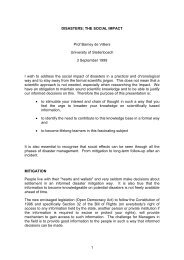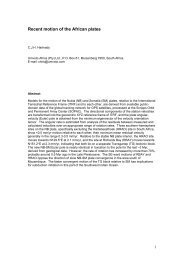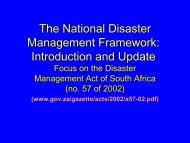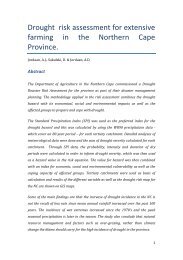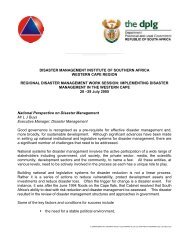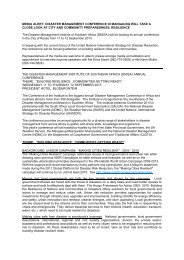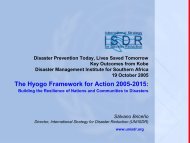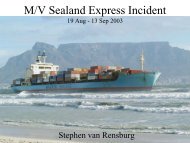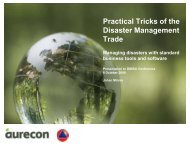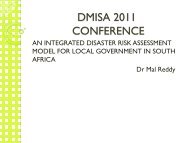BS Ngcamu, Dr. N Dorasamy - Disaster Management Institute South ...
BS Ngcamu, Dr. N Dorasamy - Disaster Management Institute South ...
BS Ngcamu, Dr. N Dorasamy - Disaster Management Institute South ...
- No tags were found...
Create successful ePaper yourself
Turn your PDF publications into a flip-book with our unique Google optimized e-Paper software.
<strong>Disaster</strong> preparedness and informal settlementsInformal settlements are deemed by the United Nations as areas where groups of housing have beenconstructed on land to which the occupants have no legal claim. These areas are characterised byrapid, unstructured and unplanned developments. They are common features of developingcountries and are typically the product of an urgent need for shelter by urban poor (Huchzermer,2001; Mason & Baltsavias, 1997 & United Nations, 2004). According to information from the<strong>South</strong> African 1996 census, 11, 6% of households lived in freestanding informal settlements, and afurther 4.5% lived in shacks in the backyards of formal houses in townships. Over 16% ofhouseholds were living in urban informal housing, and a further 18% lived in traditionallyconstructed houses which would be located mostly in rural areas. Napier & Rubin (2002:4) arguethat these figures are only broadly indicative of exposure to risk, because the location of thesettlements and the quality of the construction materials are not all evident. Informal settlementgrowth in metropolitan areas of <strong>South</strong> Africa has increased in the past decade as a result of theabolishing of legislation implemented by the apartheid government that prevented urbanisation(Ferreira et al., 2002:23). As a result of the sudden post-apartheid increase in urbanisation,metropolitan areas in <strong>South</strong> Africa were very dynamic, resulting in the rapid change of the spatialpatterns and land use associated with such areas.The 11.6% households living in freestanding informal housing are most often located on the fardistant peripheries of cities (SA Census, 1996). Vulnerability to disaster is increased as a result ofcertain qualities of the location, such as settlements on steep slopes (Inanda, Durban), within floodplains (Alexandra, Johannesburg), close to mine dumps (East Rand, near Johannesburg), close toheavy industrial areas (Wentworth, Durban), or even on landfill sites (Foreman and Kennedy Road,Durban). Other hazards arise from the nature of the settlement itself, such as risks of rapidlyspreading fire, or health risks from rising dampness, poor indoor air quality and collapsingstructures.According to the National <strong>Disaster</strong> <strong>Management</strong> Centre (NDMC) (2006/2007:12-13), naturaldisasters such as devastating floods, violent hailstorms, heavy snowfalls and gale-force winds areregular occurrences in <strong>South</strong> Africa. The <strong>South</strong> African Weather Service maintains a record ofsignificant weather events of the past and captures information such as the actual date ofoccurrence, the extent of the damage and areas affected, as well as the frequency of a particular typeof disaster occurring in a specific region. Such records are essential to government departments6



